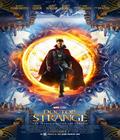Given the size and scope of the Marvel Cinematic Universe, there may not seem like a whole lot of room for yet another superhero, but Marvel has done just that with "Doctor Strange," which introduces magic to the MCU canon. As a film, "Doctor Strange" is mostly self-contained, though it does feature a handful of key name-drops that tie it in to the larger universe and guarantee Doctor Strange’s presence in "Avengers: Infinity War."
Establishing a compelling origin story is always a challenge, and with Doctor Strange, that challenge was ramped up a few notches given the character stereotypes in the comics. Bringing the story to the big screen meant either reinforcing well-trodden Asian character tropes or changing key characters and being accused of whitewashing. Director Scott Derrickson opted for the latter, but after seeing the film, it’s safe to say he made the right call. Tilda Swinton may not be an old Asian man, but she absolutely nailed the film's version of the Ancient One.
Doctor Strange's mentor and teacher, the Ancient One is also the protector of Earth and the last line of defense against mystical attacks. Swinton plays the role as more androgynous than either masculine or feminine. The Ancient One doesn't concern herself with basic issues. She is too busy focusing on how to best defend against a former student who has gone rogue. Because of this, she initially doesn't even deem Strange worthy of teaching — well that, and because when we first meet him, he's a royal jerk.
The MCU version of Strange spends the first act of the film as little more than an egotistical, self-centered narcissist who never thinks about anyone other than himself. If the characterization doesn’t make it clear enough, another character actually calls it out. The movie isn't subtle here. Derrickson doesn’t want audiences to identify with Strange at the start; he wants audiences to dislike the character.
While risky, the bold move pays off, as it makes Strange's character arc that much more dramatic. Benedict Cumberbatch makes it work because he doesn't play Strange for laughs. The narcissism isn't a defense mechanism or an attempt at humor. Cumberbatch's Strange is a broken man from the start.
Swinton and Cumberbatch command attention whenever either one is on-screen, yet both are ultimately upstaged by the film's special effects. We got a glimpse of what Marvel artists could conceive of near the end of "Ant-Man" and throughout "Guardians of the Galaxy." The stuff here is ratcheted up to 11 compared to either one of those films. The reality-bending sets are like a living M.C. Escher painting come to life. They twist. They bend. They fold in on themselves. And the whole while, a fight is going on. This doesn't just happen once. It happens over and over again throughout the film.
The best part is that the crazy effects get better with every fight. Doctor Strange's climax is one of the best choreographed final battles across the entire body of the MCU.
It is the effects that make "Doctor Strange" worth seeing on the big screen. I saw the film in Dolby 3D, and while it suffered from being overly dark due to the 3-D tech used, I can only imagine how impressive it must look on the bigger, and brighter, IMAX 3D screen. If you're going to spring for IMAX, "Doctor Strange" is a movie that is worth the extra cost.
While many effects-heavy films coast on their impressive visuals, "Doctor Strange" doesn't skimp on the humor. Benedict Wong plays Wong, the master librarian who constantly puts Strange in his place. Wong's comedic timing hits the bull's-eye every single time, and I can confidently say that no film has ever made better use of "All the Single Ladies." Wong has turned a character that was a walking stereotype in the comics into a full-fledged personality for the film.
Early on in the film, the Ancient One tells Strange that in order to gain control, he must let go. One could say that the cast and crew of "Doctor Strange" took the Ancient One's advice to heart when producing the film. There is so much in here that, for lack of a better word, likely sounded very strange on paper. Seeing it come to life on the big screen is both impressive and a testament to Marvel's commitment to its characters.
By the time the final credits roll, the only question you'll be asking yourself is, "When will we get to see more of Doctor Strange?"
Score: 8.0/10
"Doctor Strange" is rated PG-13 and has a running time of 1 hours and 55 minutes. It is showing in 2-D, 3-D and IMAX 3-D.
Editor's Note: "Doctor Strange" has both a mid-credits scene and an after-credits scene. If you leave before the credits end, you'll miss out. If you want to spend some time playing as the sorcerer supreme, be sure to check out LEGO Marvel's Avengers and Marvel Heroes, which have him as a playable character.
More articles about Doctor Strange











 A former neurosurgeon embarks on a journey of healing only to be drawn into the world of the mystic arts.
A former neurosurgeon embarks on a journey of healing only to be drawn into the world of the mystic arts.























































